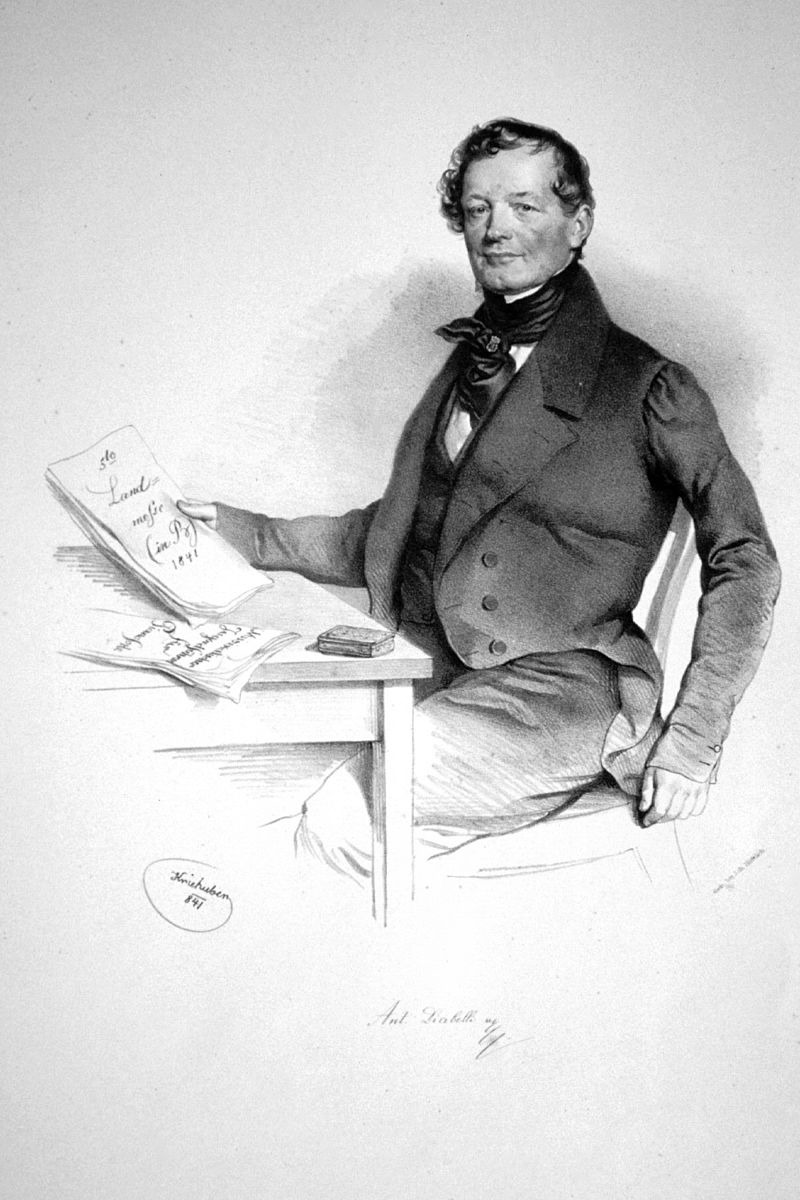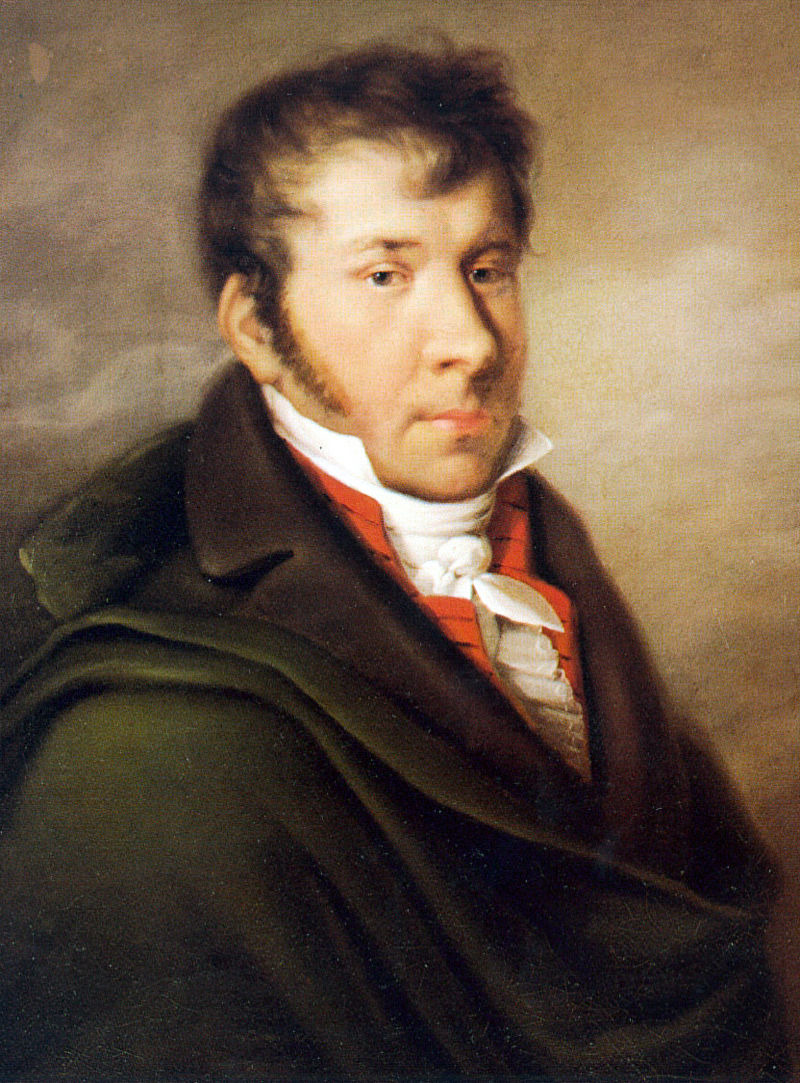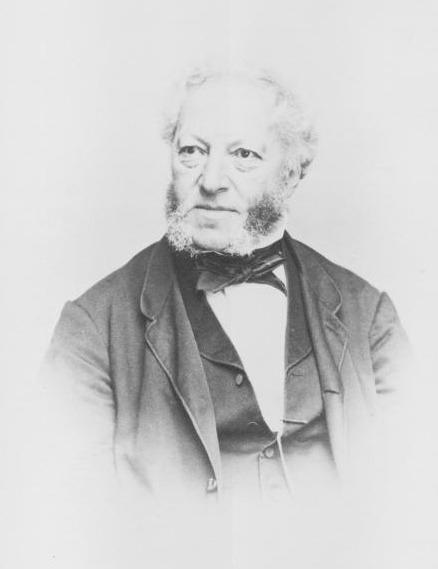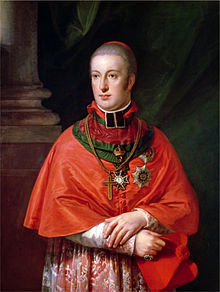It’s one of those things – you come up with a great project, you get a lot of people involved, they give you brilliant stuff and then one person comes along and trumps everything. And so it was with Anton Diabelli. In 1819, he decided to publish a set of variations based on a waltz he’d written. The important difference was that he didn’t write the variations. He sent his waltz out to every important Austrian composer living, and a couple of non-Austrians, and they sent him back their own variation on his melody.

Anton Diabelli by Jpseph Kriehuber
This was to be published as a work entitled Vaterländischer Künstlerverein (The Patriotic Artist’s Club). Fifty-one composers complied, sending in their single variations, except for that over-achiever Beethoven, who sent in a set of 33 variations.
Anton Diabelli: 50 Variations on a Waltz by Diabelli – Theme (Artur Balsam, piano)
The list of composers (see below) is interesting, however. Of the 51 composers, we know very few of them today. They may have been important in 1819, but by 2016, most had vanished off the musical scene. Let’s take a look at what Diabelli reaped (ignoring Beethoven’s contribution).
Carl Czerny wrote only a little 30-second piece, but, more importantly, he had his student, the eight-year-old Franz Liszt contribute.
Carl Czerny: 50 Variations on a Waltz by Diabelli – Variation 4 (Artur Balsam, piano)
Franz Liszt: 50 Variations on a Waltz by Diabelli – Variation 24, S147/R26 (Artur Balsam, piano)

Johann Nepomuk Hummel (c.1814)
We can immediately hear the precocity of Liszt’s contribution. No delicate dance work for him, as we heard in the Czerny variation, he launches out immediately with bold gestures and a strong bass line.
Mozart’s student, Johann Nepomuk Hummel, can be contrasted with one of Hummel’s own students, Mozart’s son Franz Xaver Mozart, born some 5 months before his father’s death.
Johann Nepomuk Hummel: 50 Variations on a Waltz by Diabelli – Variation 16, S161 (Artur Balsam, piano)
Franz Xaver Mozart Mozart: 50 Variations on a Waltz by Diabelli – Variation 28 (Artur Balsam, piano)

Ignaz Moscheles by August Brasch
Ignaz Moscheles, considered one of the leading piano virtuosos in Vienna of the time, also contributed a variation, as did Franz Schubert. Here we can hear the difference between a master virtuoso on the piano and a master virtuoso of song. Schubert takes the variation to the minor and gives it a poignancy that we’ve missed in the other variations.
Ignaz Moscheles: 50 Variations on a Waltz by Diabelli – Variation 26 (Artur Balsam, piano)
Franz Schubert: 50 Variations on a Waltz by Diabelli – Variation 38, D. 178 (Artur Balsam, piano)
One of the surprising composers in the list and one who contributes an interesting contrapuntal variation was Rudolph, Archduke of Austria. He began to take lessons around 1803 from Beethoven and we can hear that Beethovenian bravado in his variation.

Rudolf von Habsburg-Lothringen by Johann Baptist von Lampi the Elder
Rudolph, Archduke of Austria: 50 Variations on a Waltz by Diabelli – Variation 40 (Artur Balsam, piano)
The coda to the whole project was supplied by Carl Czerny, who had quite a task to bring this tremendous variation set to a close (which he does quite dramatically).
Carl Czerny: 50 Variations on a Waltz by Diabelli – Coda (Artur Balsam, piano)
List of composers (alphabetically)
Ignaz Assmayer
Ludwig van Beethoven
Carl Maria von Bocklet
Leopold Eustache Czapek
Carl Czerny
Joseph Czerny
Anton Diabelli
Joseph Drechsler
Emanuel Aloys Forster
Franz Jakob Freystadtler
Johann Gansbacher
Josef Gelinek
Anton Halm
Johann Hoffmann
Johann Horzalka
Joseph Huglmann
Johann Nepomuk Hummel
Anselm Huttenbrenner
Frederic Kalkbrenner
Friedrich August Kanne
Joseph Kerzkowsky
Conradin Kreutzer
Heinrich Eduard Josef von Lannoy
Marcus Leidesdorf
Franz Liszt
Joseph Mayseder
Ignaz Moscheles
Ignaz Franz von Mosel
Franz Xaver Mozart
Joseph Panny
Hieronymus Payer
Johann Peter Pixis
Wenzel Plachy
Gottfried Rieger
Philipp Jakob Riotte
Franz de Paula Roser
Rudolph (Archduke of Austria)
Johann Baptist Schenk
Franz Schoberlechner
Franz Schubert
Simon Sechter
Abbe Maximilian Stadler
Joseph von Szalay
Vaclav Jan Kritel Tomasek
Michael Umlauf
Jan August Vitasek
Graf Moriz von Dietrichstein
Jan Hugo Vorisek
Franz Weber
Friedrich Dionys Weber
Franz Weiss
Charles Angelus von Winkhler
For more of the best in classical music, sign up to our E-Newsletter

Any idea why Reicha was not invited?
He, Reicha, was writing his own superb Op. 57 L’Art de Varier, theme in F major and 57 variations which, personally, I would love to listen to in a recital alongside Beethoven’s Diabelli. I know at least two recordings of this opus (Mauro Masala, Dynamic, and Ivan Ilic, Chandos).
The same could be told of the so neglected Reger’s Variations on a Theme by Telemann Op. 134….
Reicha had actually already written his L’Art de Varier 15 years earlier – it had been composed in 1803/04 for Prince Louis Ferdinand and published in 1804. As Diabelli had invited only Austrian composers (with a couple of others) for a work he intended to publish as Vaterländischer Künstlerverein (The Patriotic Artist’s Club), the Czech-born, Paris-living Reicha might have been too much of a stretch for Diabelli, despite Reicha having been teaching and composing in Venice from 1801 (with intermittent departures in 1805 and other dates because of Napoleon’s invasion). By 1818, Reicha was in Paris, where he remained for the rest of his life.